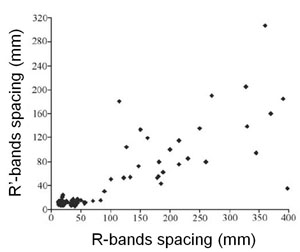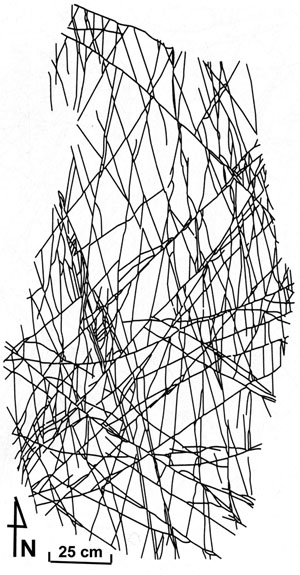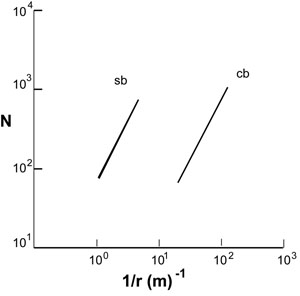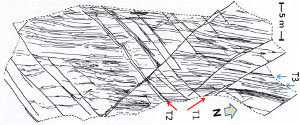| |||||||
|
|
|||||||
|
|
|||||||
| Geostatistical Properties of Multiple Deformation Band Sets | |||||||
|
We have documented and analyzed the geometric, statistical and scaling properties of individual and single sets of deformation bands of shear and compaction kinds in corresponding discussions marked by proper links. Presumably, the methods used there and the results obtained are applicable for individual members and sets within multiple sets of deformation bands with the caveat that the earlier sets have a substantial affect on the properties of the sets which formed later. To illustrate this phenomenon, it is sufficient to examine the maps in Figure 1a and b and the spacing plots (Figure 2) of the two sets of shear bands identified as R and R' following the nomenclature used for the so-called Riedel shears. A casual inspection may reveal that the spacing and the length of the two sets are different, which is also evident in the plot in Figure 2. Note that this affect is similar to that of other structure types that we presented under corresponding classes (joints. pressure solution bands, and faults). Nevertheless, the term, hierarchical property that was used for faulting, can also be used to describe the shear band system in the maps in Figure 1a and b. Although the mechanisms affecting the statistical properties such as length and spacing of the sets may be different but the resulting dimensional properties are comparable. It is more appropriate to use an area-based method for evaluating the statistical properties of structure networks in two dimension rather than line-based methods which are one dimensional. For example, Figure 3 shows a map of a network of shear bands in a sandstone sample of the Morrison Formation (Barton, 1995). A box counting method called box-flex was used to analyze scaling and clustering of the shear bands network shown in Figure 3. The author determined that the data indicates a fractal distribution (Figure 4) with a fractal dimension of 1.50.
2D and 3D patterns of compaction bands are extremely complicated. Using a trace map (Figure 5), Barton, similar to his analysis of shear bands mentioned above, determined that the compaction bands network has a fractal dimension of 1.58. | |||||||
| Reference: |
|||||||
| Barton, C.C., 1995 Hill, R.E., 1989 Katz, Y., Weinberger, R., Aydin, A., 2004 |
|||||||
|
Readme | About Us | Acknowledgement | How to Cite | Terms of Use | Ⓒ Rock Fracture Knowledgebase |
|||||||




